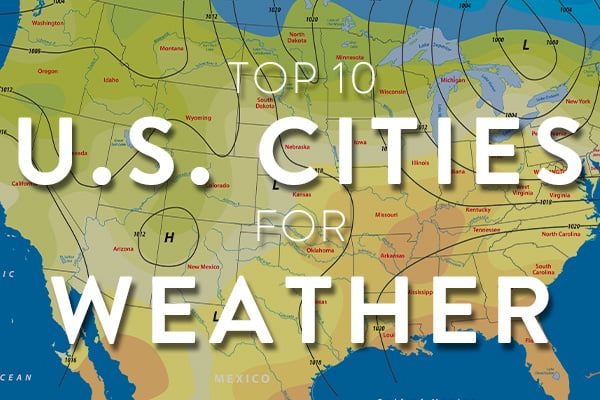
Top 10
U.S. Cities
for Weather
There’s no denying that the climate and weather of a location can be a heavy consideration when deciding where to live.
Extreme weather conditions can impact your quality of life, with severe hot and cold weather becoming more common due to climate change, putting people’s health and safety in question.


In contrast, certain types of weather can be selling points for specific locations, offering mild and comfortable temperatures that make everyday activities more enjoyable.
Everyone has a different ideal weather situation, with some loving the cold and others wanting nothing more than to sit out in the sun with soaring temperatures all day.

So, if you’re planning to move to a different city in the U.S., and the weather is one of your most significant considerations, you’re in the right place.
To provide you with a thorough understanding of the different weather patterns here in the U.S., we’ve compiled a list of the top 10 U.S. cities with enjoyable weather all year round.
10
San Francisco, California

Regarded as the cultural center of Northern California, San Francisco is a favored place to reside and is popular with tourists. Visitors can have their minds blown by the magnificent sight of the Golden Gate Bridge, taking in all the beauty that this coastal city has to offer.
Weather Patterns and Climate
Summertime spans from June to August, with these months offering cool, foggy weather. Temperatures range from the mid-50s to the mid-60s Fahrenheit (13 to 18 degrees Celsius), with occasional heat waves reaching the 70s or 18s Fahrenheit (21 to 27 degrees Celsius). Although these temperatures are cool considering its summer, this season is a popular visiting time for tourists.
Spring lasts from March-May and is one of the best times to visit San Francisco due to the beautiful foliage scenery. Temperatures average from the mid-50s to the mid-60s Fahrenheit (13 to 18 degrees Celsius), with rainfall becoming less common.
San Francisco provides mild, comfortable winters, seeing average temperatures range from the mid-40s to the mid-50s Fahrenheit (7 to 13 degrees Celsius) from December to January. Rainfall is expected during this time, with January receiving the most and being the wettest month.
Fall (September – November) is an excellent time for visiting San Francisco, providing sunny, warm days and cooler evening temperatures. Average temperatures range from the mid-50s to mid-60s Fahrenheit (13 to 18 degrees Celsius), similar to summer. November sees rainfall increase as the city gears up for winter.
Why is San Francisco Highly Regarded for its Weather?
Although it’s clear that San Francisco isn’t as warm as other cities in the States, many residents and visitors love the mild climate the city has to offer for the following reasons;
09
Asheville, North Carolina
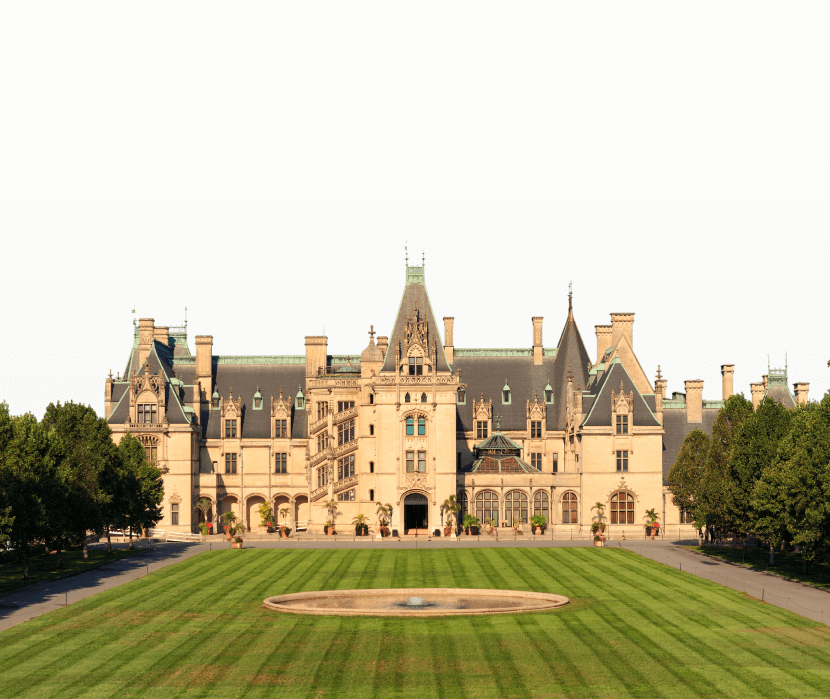
Asheville is a mountainous city in North Carolina, delivering stunning views surrounded by nature with a charming downtown bubbling with art, music, and eateries worth visiting. The city’s main selling points are accompanied by pleasant and varied seasonal weather.
Weather Patterns and Climate
The Spring months of March-May are one of the best times to visit Asheville, providing comfortable temperatures ranging from the mid-40s to the mid-60s Fahrenheit (7 to 18 degrees Celsius), with moderate rainfall. This comfortable climate delivers the perfect weather for enjoying Asheville’s Spring nature, with breathtaking scenery of blooming flowers and trees taking over the city.
Summer runs from June – August and delivers a warm, humid environment with temperatures averaging from the mid-60s to the mid-80s Fahrenheit (18 to 29 degrees Celsius). Asheville’s humidity is broken up by afternoon thunderstorms, providing relief from the heat.
Ashville’s scenery is rich with nature and trees, so Fall is a beautiful time to visit the city, providing a stunning display of autumnal colors. During Fall (September – November), temperature averages between the mid-40s and mid-70s Fahrenheit (7 to 24 degrees Celsius), with moderate rainfall.
The Winter months are from December – February, providing a typically mild environment with occasional snowfall. Temperatures average between the mid-20s and mid-50s Fahrenheit (14 to 13 degrees Celsius), with clear, crisp, wintery days expected throughout the season.
Why is Asheville Highly Regarded for Its Weather?
The above points indicate that Asheville has a relatively varied climate throughout the year, providing something for everyone’s weather preference during different seasons. Let’s take a look at why the city is hailed for its weather;
08
Savannah, Georgia
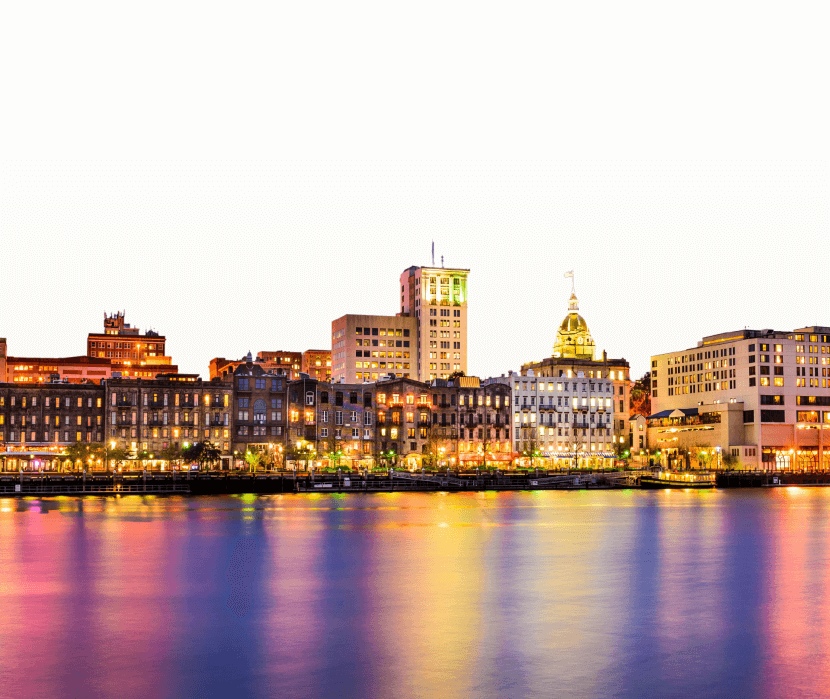
Savannah is a coastal city in Georgia, providing residents with remarkable parks and nature, vibrant, historic architecture, and a picturesque coastline. Let’s look at how the weather matches all this city has to offer;
Weather Patterns and Climate
Summer in Savannah runs from May to September, with temperatures reaching 90 to 95 degrees Fahrenheit (32 to 35 degrees Celsius) during the day. Temperatures don’t drop too low at nighttime, with 70 degrees Fahrenheit (21 to 26 degrees Celsius) being the average. The weather is usually humid during this season, with afternoon breezes and occasional thunderstorms.
Savannah is located on the coast, so humidity and occasional tropical storms occur during the hurricane season, which lasts from June to November. Similarly to Charleston, this city has low elevation, which makes flooding a more prevalent issue.
Wintertime, which starts in December and ends in February, provides a much cooler climate. Daytime temperatures drop to 50 and 60 degrees Fahrenheit (10 to 15 degrees Celsius), while temperatures can go as low as 30 to 40 degrees Fahrenheit (0 to 5 degrees) during the night. This season sees weather remain mild and comfortable, with occasional rainfall.
Why is Savannah Highly Regarded For its Weather?
There are clear pros and cons to the coastal location of Savannah regarding the weather, but many people choose to reside here despite the cons.
07
Charleston, South Carolina
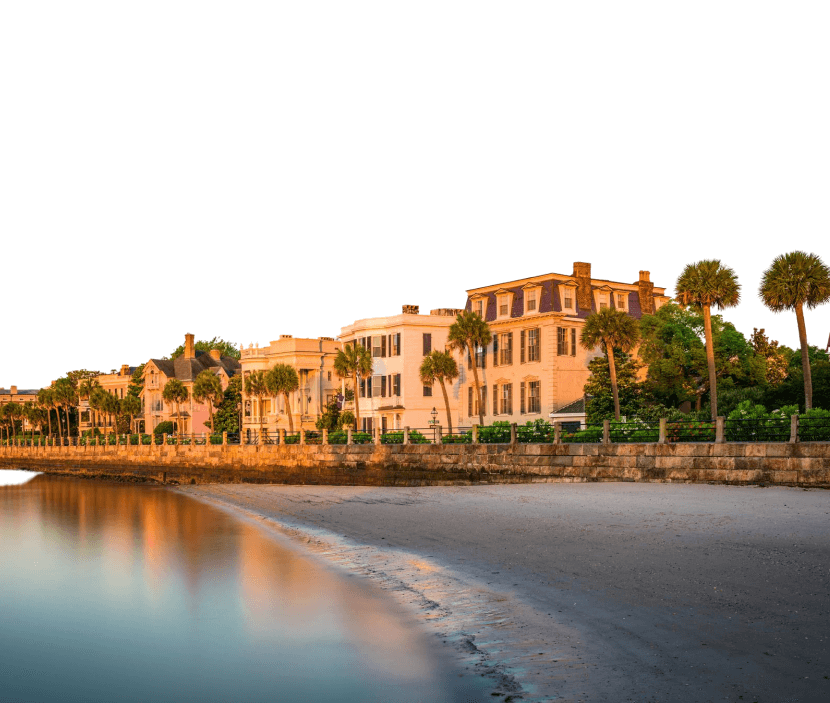
Charleston is South Carolina’s largest city, providing residents with a culture-rich place to live, bursting with beautiful landscapes and entertaining attractions championed by excellent weather.
Weather Patterns and Climate
Charleston’s summer runs from May to September, with temperatures varying from 85 to 90 degrees Fahrenheit (29 to 32 degrees Celsius) during the day, dropping to 70 degrees Fahrenheit (21 to 26 degrees Celsius) at night. Typically, Charleston’s summer weather is humid, with afternoon sea breezes and the occasional thunderstorm.
Charleston is a coastal location; therefore, its position heavily affects the climate and weather, with conditions such as humidity and tropical storms during the hurricane season from June to November being poignant. With such close proximity to the ocean and low land elevation, Charleston is prone to flooding.
Winter (running from December to February) sees Charleston’s temperatures drop to 40/ 50 degrees Fahrenheit (4 degrees Celsius) during the day and drop even lower at night to 30 degrees Fahrenheit (0 to 4 degrees Celsius). The weather is generally mild and comfortable during these months, with occasional rainfall.
Why is Charleston Highly Regarded For its Weather?
Although there are a couple of negatives regarding Charleston’s climate and weather, there are plenty of reasons why visitors fall in love with what the city’s climate has to offer;
06
Albuquerque, New Mexico
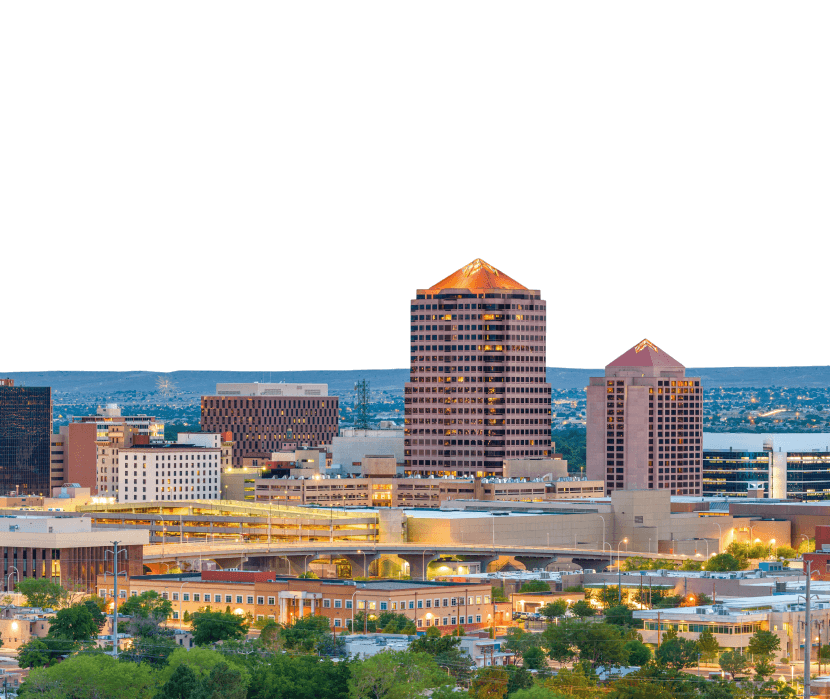
Albuquerque is the largest city in New Mexico and is another destination on our list based in a desert climate, in which this city merges modern elements with old-town architecture and culture for a diverse and exciting place to reside.
Weather Patterns and Climate
The summer of Albuquerque runs from May to September, providing high temperatures reaching 90 to 95 degrees Fahrenheit (32 to 35 degrees Celsius) during the day. Nighttime sees temperatures drop to the 60s (15 to 20 degrees Celsius), providing a mild, comfortable evening temperature. The summer offers a low-humidity, sunny season with occasional afternoon thunderstorms.
Albuquerque’s location in the southwesterly high desert region creates a high altitude, with occasional wind and dust storms occurring during the spring.
The winter months from November to February see temperatures drop significantly low, to 30s and 40s degrees Fahrenheit (0 to 5 degrees Celsius) during the day, with below-freezing temperatures occurring at night. The winter season is cold but remains dry, with only occasional winter storms and snowfall.
Why is Albuquerque Highly Regarded For its Weather?
Although Albuquerque has cold winters and occasional storms, there are many good points to be discovered with its weather, particularly during the summer and fall months.
05
Las Vegas, Nevada

There’s no denying that Las Vegas is a fascinating place to be, with some of the best entertainment and sights in the entire world. With its desert climate, the weather also provides something to get tourists and residents talking.
Weather Patterns and Climate
Summer in Las Vegas typically starts in May, ending in September, with temperatures reaching between 100 and 110 degrees Fahrenheit (38 to 43 degrees Celsius) during daylight hours. Summertime is usually sunny, with little rainfall and low humidity.
Las Vegas is located in the Mojave Desert, significantly influencing its climate. The main characteristics of this climate are hot, dry weather conditions with dust storms and flash floods during the summer months and some freezing temperatures, and occasional snowfall during winter.
Winter provides mild, comfortable weather conditions with occasional rainfall from October to April. Temperatures in this season vary between 55 and 65 degrees Fahrenheit (13 to 18 degrees Celsius) during the day and 35 to 45 degrees Fahrenheit (2 to 7 degrees Celsius) at night. This is quite a jump from summer temperatures, but as the climate is generally dry, these conditions are still better than in many other cities.
Why is Las Vegas Regarded For its Weather?
Although colder winter months and extreme weather conditions come with being in a desert, many residents love the weather that Vegas provides. Here’s why;
04
Phoenix, Arizona
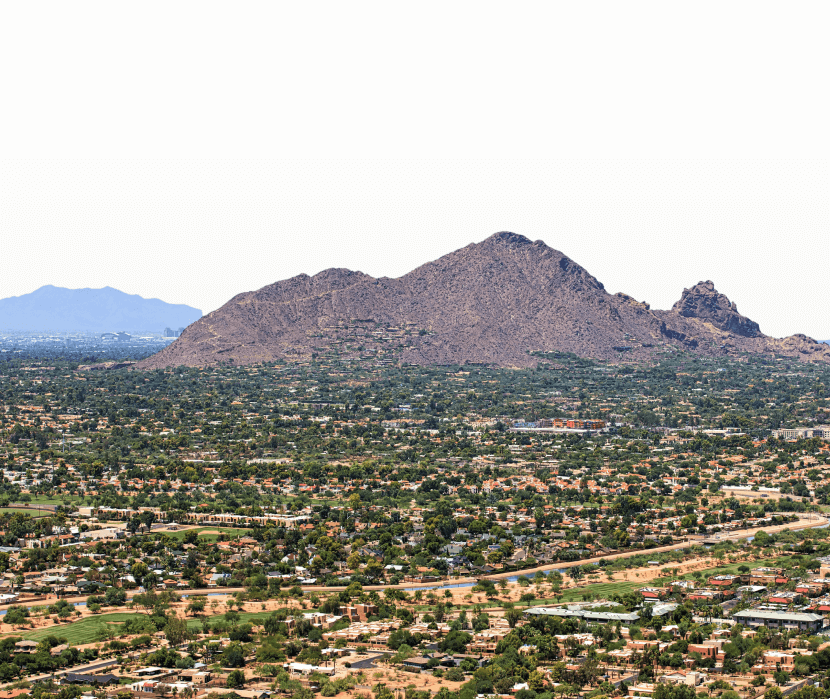
Phoenix is the capital city of the state of Arizona and is becoming regarded as one of the top cities to live in the country. From desert beauty, friendly environments, and suburban life, this area has plenty of great selling points, and the weather isn’t bad either!
Weather Patterns and Climate
Running from May to September, Phoenix’s summer months are scorching hot, reaching between 100 to 110 degrees Fahrenheit (38 to 43 degrees Celsius) during the daytime. Throughout the night, temperatures can remain in the 80s to 90s (27 to 32 degrees Celsius). The summer provides a dry, sunny environment with low humidity and very little rainfall, perfect for any sun lovers.
It’s important to note that Phoenix is located in the Sonoran Desert, so the city’s climate is heavily impacted by this, with hot and dry conditions occurring throughout the year. Additionally, Phoenix also experiences monsoon season and occasional dust storms, which sees intense thunderstorms, heavy rainfall, and high winds bringing slightly unsettling condition to the area.
Temperatures in Phoenix are significantly lower in the Winter months of October to April. However, they aren’t too cold that it’s unbearable, providing a mild, comfortable environment with occasional rainfall. Daytime temperatures generally range from 65 and 75 degrees Fahrenheit (18 to 24 degrees Celsius), with nighttime temperatures falling between 45 and 55 degrees Fahrenheit (7 to 13 degrees Celsius).
Why is Phoenix Highly Regarded For its Weather?
Of course, to some, the monsoon season may sound off-putting, but there are several reasons that Phoenix’s weather is appealing enough to consider living here;
03
Honolulu, Hawaii

Honolulu is the capital of Hawaii, offering residents and tourists the best of both worlds; shops, exciting architecture, nightlight, and serene nature such as beaches and striking volcanic backdrops. And the weather is something to be proud of too.
Weather Patterns and Climate
The summer months of May to October in Honolulu are warm but not scorching, with temperatures ranging from 80 to 90 degrees Fahrenheit (27 to 32 degrees Celsius) during the day. Nightime remains warm, with 70 to 75 degrees Fahrenheit (21 to 24 degrees Celsius) being the usual temperature range. During summer, the weather is hot and humid, with occasional rainfall and cooling trade winds.
As Hawaii is in the Pacific Ocean, the sea heavily influences Honolulu’s climate. This moderates humidity and temperature levels, preventing residents from feeling too uncomfortable in the warmer months. However, the city does experience tropical thunderstorms on occasion, most commonly in the summer.
Although winter in Honolulu is cooler and drier than summer, it’s still a warm climate and can have occasional rainfall and stronger trade winds. From November to April, daylight temperatures tend to range between 75 and 80 degrees Fahrenheit (24 to 27 degrees Celsius) and 65 to 70 degrees Fahrenheit (18 to 21 degrees Celsius) at night.
Why is Honolulu Highly Regarded For its Weather?
With Honolulu offering so much for those visiting, it’s interesting to see how much the weather plays a part in the city’s appeal due to several factors;
02
Santa Barbara, California

Santa Barbara is another location on our list situated in California.
The coastal city is highly regarded due to the beautiful Ynez mountainous backdrops, pristine sandy beaches, and charming Mediterranean-style architecture.
Weather Patterns and Climate
The summer in Santa Barbara usually starts in June and lasts until October, seeing daytime temperatures get to highs of 80 degrees and lows of 70 degrees Fahrenheit (21 to 27 degrees Celsius). At night, temperatures range from 55 to 65 degrees Fahrenheit (13 to 18 degrees Celsius). During the summer, weather typically provides low humidity, little rainfall, and blissful sun spells.
Another essential summer weather characteristic in Santa Barbara is coastal fog, which provides a natural air conditioning effect throughout the early summer mornings. The fog usually burns off by mid-morning, clearing the way for sunny skies and warm temperatures by noon.
Wintertime commences in November and finishes in May, with ranges in temperature dropping around 10 degrees to 60 – 70 degrees Fahrenheit (15 to 21 degrees Celsius) during the day and 45 to 55 degrees Fahrenheit (7 to 13 degrees Celsius) at night. This season sees more humidity, with a cooler climate and occasional rainfall.
Why is Santa Barbara Highly Regarded For its Weather?
Santa Barbara has many great selling points for tourists and those searching for a new city to live in, but how does weather affect the city’s reputation?
01
San Diego, California
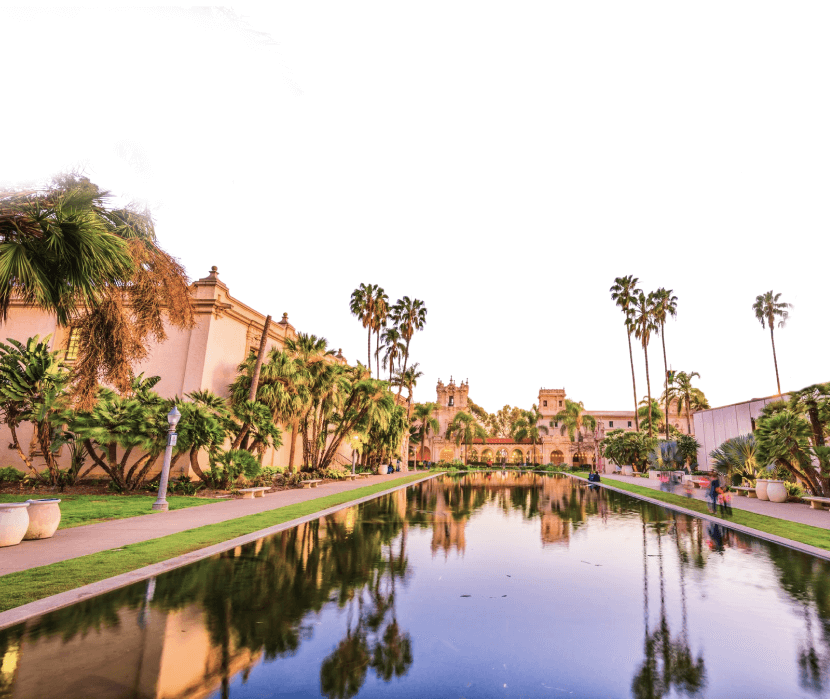
Situated on California’s Pacific coast, San Diego has much to offer those looking to relocate, from magnificent beaches to deep historical significance. But what’s the weather like?
Weather Patterns and Climate
Summer in San Diego usually starts in June and ends in October, with temperatures ranging from 70 to 80 degrees Fahrenheit (21 to 27 degrees Celsius) during the daytime. In the nighttime, temperatures usually drop to around 60 to 70 degrees Fahrenheit (15 to 21 degrees Celsius).
These temperatures are ideal for those who enjoy the heat but don’t want a climate too overpowering so that the heat won’t distract you from your daily activities. Additionally, summertime sees a generally sunny climate with low humidity and minimal rainfall.
Winter temperatures are pretty mild, seeing temperatures between 60 and 70 degrees Fahrenheit (15 to 21 degrees Celsius) through the daytime in the months of November to May. Nighttime temperatures range from 50 to 60 degrees Fahrenheit (10 to 15 degrees Celsius) at night. During the winter, San Diego’s weather is more humid, with occasional rainfall and cooler temperatures.
Why is San Diego Highly Regarded For its Weather?
There are a range of reasons that San Diego is highly regarded for its weather and why the city’s climate is a selling point for many homeowners.
Conclusion

Whether you’re deciding on a place to visit this summer to escape the heat or looking for somewhere warmer during winter, the U.S. has many incredible cities to visit or reside in.
Our list provides a guide for the cities with the best year-round weather in the U.S., with options that suit various interests and tastes. Enjoy the striking architecture and the sweltering heat of Albuquerque during the summer, or the rich autumnal foliage of Asheville during the Fall, paired with mild temperatures for a comfortable visit.
Overall, the weather in a city can significantly impact your time spent in the area, so understanding the type of climate that suits you can ensure your next trip or house move is a success and reflects your needs.
Which US city has the best year-round weather?
The US city that is often considered to have the best year-round weather is San Diego, California. With its mild temperatures, low humidity, and abundant sunshine, San Diego offers a pleasant climate throughout the year, making it a popular destination for those seeking ideal weather conditions.
Which place in the USA has the best climate?
Determining the best climate in the USA is subjective as it depends on personal preferences. However, some places known for having pleasant climates include San Diego, California, with its mild temperatures and low humidity, and Honolulu, Hawaii, known for its tropical climate and beautiful beaches. Other regions, like Santa Barbara, California, and Charleston, South Carolina, are also popular for their favorable climates. Ultimately, the best climate will vary based on individual preferences for temperature, humidity, and other factors.
What is the hottest city in the US?
The hottest city in the US varies depending on the time of year and specific weather patterns. However, some cities that are commonly known for their hot temperatures include Phoenix, Arizona, Las Vegas, Nevada, and Palm Springs, California. These cities experience scorching temperatures during the summer months, often reaching well above 100 degrees Fahrenheit.
Which US city has the coolest summers?
The US city that is often regarded as having the coolest summers is San Francisco, California. Due to its location near the Pacific Ocean, the city experiences a cool and foggy climate during the summer months, with temperatures rarely exceeding 70 degrees Fahrenheit.
Where is the sunniest place year-round in the US?
The sunniest place year-round in the US is generally considered to be Yuma, Arizona. With an average of over 300 sunny days per year, Yuma experiences very little cloud cover and consistently high levels of sunshine.
Which US city has the lowest average temperature each year?
The US city with the lowest average temperature each year is Fairbanks, Alaska.
What is the best US city with warm weather and a low cost of living?
Phoenix, Arizona, is the best US city to live in for warm weather and a low cost of living. It has 300 sunny days per year and a warm climate all year round. The cost of living in Phoenix is low compared to other major cities. Housing prices are affordable and the overall cost of goods and services is reasonable. Phoenix has outdoor activities and a good job market, making it attractive for those seeking warm weather and an affordable lifestyle.
